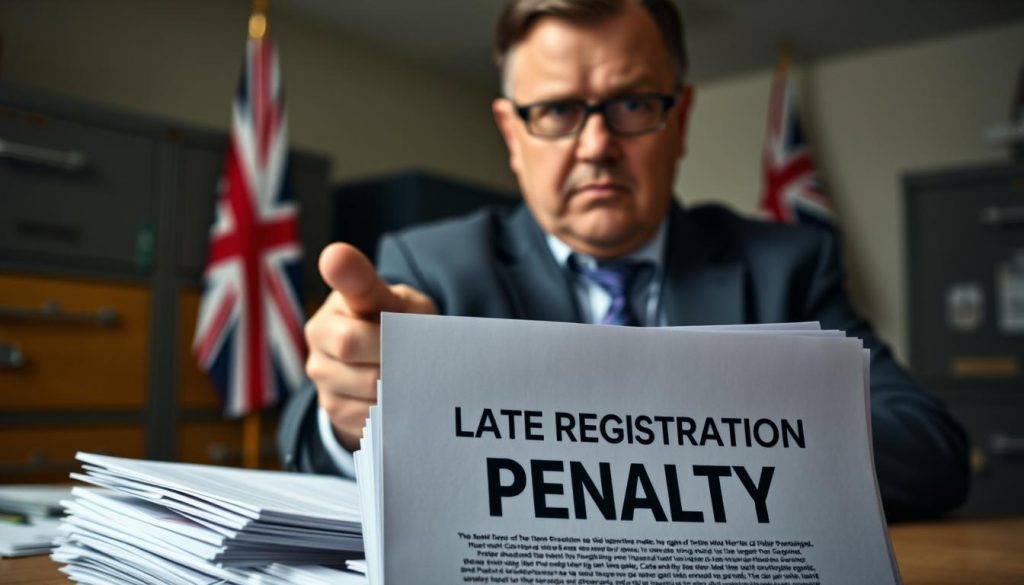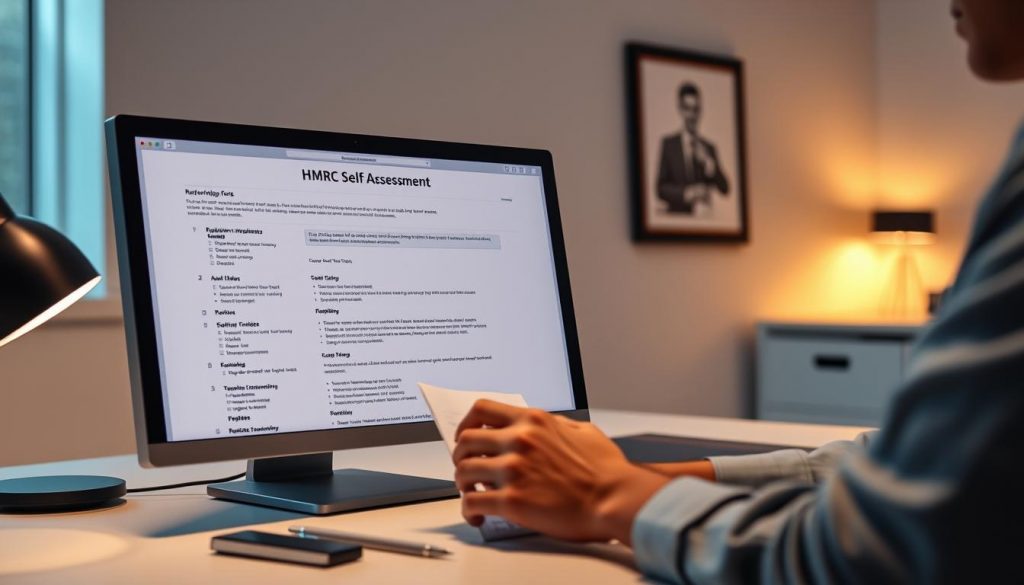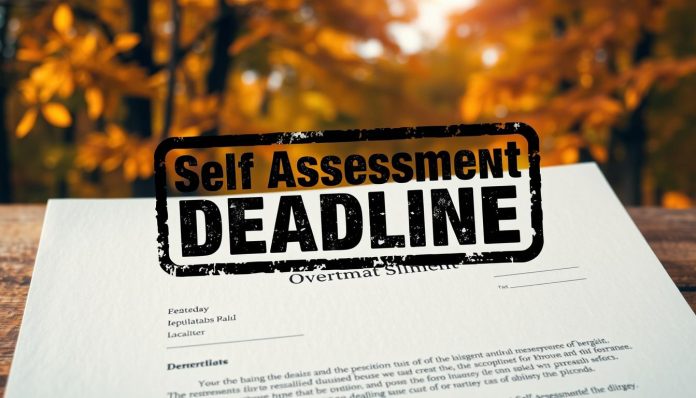With savings rates reaching heights not seen in over a decade, a silent shift is happening across the UK. Many individuals are unknowingly approaching a financial threshold that could land them with a tax obligation for the very first time.
This change makes a specific calendar date incredibly significant for a wider group of people than in previous years. It’s the final opportunity to inform the tax authorities about your income for the last financial period.
Ignoring this obligation is not an option. The government imposes strict financial penalties for those who fail to notify them on time. This can also cause significant delays to any potential refunds you might be owed.
Financial experts, like Kevin Mountford from Raisin UK, highlight that the current economic climate makes this deadline more critical than ever. Acting now is the only way to avoid complications and potential fines.
Key Takeaways
- The deadline to inform HMRC of your income for the 2024/2025 tax year is the 5th of October.
- Rising interest rates mean more people may exceed their personal savings allowance and need to complete a tax return.
- Failing to register by the specified date can result in immediate financial penalties from HMRC.
- Timely registration is essential to ensure you receive any tax refunds or reliefs you are entitled to without delay.
- This process applies to those with income from self-employment, savings, or other sources not taxed at source.
The Immediacy of the October 5th Registration Deadline
Higher interest rates on savings accounts have created a new financial reality for many people. More individuals than ever before may find themselves needing to complete a tax return for the first time. This makes the October date especially significant this year.
Acting before the cut-off is essential to avoid problems. Waiting too long can lead to penalties and delays. It is far better to be proactive with your financial obligations.
Why This Tax Year is Different for Savers
Interest rates on savings have risen sharply. At the same time, tax thresholds have remained frozen. This combination means a much larger group of people will exceed their tax-free allowance on savings interest.
Kevin Mountford from Raisin UK notes the change in landscape. “It’s not just those with large savings who are affected now,” he explains. People with modest amounts put away could also have a tax liability.
Many may not even realise they need to inform the authorities. They might only find out when they get an unexpected letter about their tax code. This could result in an unwelcome reduction in their take-home pay.
Understanding the Personal Savings Allowance Thresholds
The Personal Savings Allowance (PSA) sets how much interest you can earn tax-free. The amount depends on which income tax band you are in.
- Basic-rate taxpayers can earn £1,000 in savings interest each year without paying tax.
- Higher-rate taxpayers have a lower allowance of £500.
- Additional-rate taxpayers receive no allowance at all.
With some accounts now paying around 5%, it doesn’t take much to go over these limits. A basic-rate taxpayer with just over £19,600 in savings could breach their £1,000 allowance. A higher-rate taxpayer would exceed their £500 allowance with savings above £9,800.
The number of people facing a bill on their savings has skyrocketed. It is estimated that 2.64 million will pay this tax in the 2025/26 year. This is a huge jump from the 647,000 people affected just a few years ago.
The government expects to collect over £6 billion from savings interest this year. This shows the sheer scale of the issue. It affects ordinary households, not just the wealthy.
Everyone should check their savings and the interest they have earned. If you think you might be over your allowance, you must act before the October cut-off. Registering on time is the only way to steer clear of fines and surprises.
Who Must Register for Self Assessment by October 5th?
Many individuals find themselves needing to complete a tax return for the first time this year. The rules around who must register can seem complex at first glance.
Understanding your obligations is essential to avoid potential penalties. Several specific groups of people have a legal requirement to notify the authorities about their income.
Sole Traders and the £1,000 Trading Allowance
Self-employed individuals operating as sole traders have particular registration requirements. The trading allowance provides some relief for smaller operations.
You must register if your self-employment income exceeded £1,000 in the last tax year. This threshold applies even if you have another job or receive other income.
The trading allowance means you don’t pay tax on the first £1,000 of trading income. However, you still need to complete a return if your total business income surpasses this amount.
Landlords and Untaxed Income from Property
Property owners receiving rental income represent another group that often needs to register. This applies whether you rent out residential or commercial properties.
If your rental income hasn’t been taxed at source, you likely need to complete a self assessment return. This includes income from both long-term lets and holiday rentals.
Many landlords mistakenly believe their letting agent handles all tax matters. Ultimately, the responsibility lies with the property owner to declare their income properly.
Those with Significant Savings Interest or Side Hustles
Individuals earning interest above their personal savings allowance must also consider registration. As interest rates have risen, more people find themselves in this position.
Various side hustles and online selling activities now create tax obligations. Platforms like eBay, Vinted, and Etsy have started reporting seller income to the authorities.
Even casual selling can accumulate to amounts requiring declaration. The same applies to income from rental platforms like Airbnb.
| Group | Registration Threshold | Key Considerations |
|---|---|---|
| Sole Traders | Income over £1,000 | Trading allowance applies, UTR required |
| Landlords | Any untaxed rental income | Includes residential and commercial properties |
| Savings Investors | Interest above PSA | Basic rate: £1,000, Higher rate: £500 |
| Side Hustle Operators | Income above £1,000 | Platforms now report to HMRC |
| Company Directors | Additional untaxed income | Dividends above £500, other sources |
Company directors should note they might need to register even if most income comes through PAYE. This applies if they receive dividends above £500 or have other untaxed income sources.
Anyone with total untaxed income above the personal allowance threshold of £12,570 must register. This includes combinations of different income types that together exceed the limit.
During the registration process, you’ll receive a Unique Taxpayer Reference (UTR). This ten-digit number identifies you for all future correspondence with the tax office.
Review all your income sources carefully before the October cut-off. This includes self-employment, property, investments, and any side activities generating money.
Missing the notification date can lead to automatic penalties. Acting before the specified time ensures you remain compliant with your tax obligations.
Crucial HMRC Deadline: Register for Self Assessment by Oct 5
The Consequences of Missing the Crucial HMRC Deadline
Overlooking the registration cut-off exposes individuals to automatic penalties and interest charges. These financial consequences can accumulate quickly, creating significant additional burdens beyond the original tax liability.
Timely action remains the most effective way to avoid these complications. Understanding the potential outcomes helps emphasise the importance of meeting the notification date.

Failure to Notify Penalties and Fines
The authorities impose a structured penalty system for those who miss the notification window. This ‘failure to notify’ charge calculates as a percentage of the unpaid tax amount.
Penalties typically range from 0% to 30% of the tax due, depending on circumstances. Deliberate withholding of information can result in the highest penalty rates.
Seb Maley of Qdos warns about these substantial financial implications. “The penalties aren’t just numbers on paper—they represent real financial setbacks for ordinary people,” he notes.
Interest Charges and Increased Scrutiny
Interest charges apply daily from the due date until full payment is received. This compounds the financial burden of late registration and payment.
Persistent delays may trigger increased scrutiny from the tax office. This could include audits or investigations into your financial affairs.
Modern technology makes detection more likely than ever before. Platforms including Airbnb, Vinted, eBay and Etsy now report seller income directly to the authorities.
This automated information sharing means the tax office can easily identify those who should have registered but didn’t. The old assumption that small earnings might go unnoticed no longer applies.
There is some potential leniency for those who act quickly after missing the date. Registering late but paying in full by the January 31 deadline might reduce penalties to zero.
However, this discretionary approach shouldn’t be relied upon. The safest approach remains meeting the original October notification requirement.
Beyond financial penalties, delayed registration can postpone any tax refunds or reliefs you’re owed. This creates further cash flow problems for individuals and businesses.
Maintaining accurate records of income and expenses becomes even more important if you register late. Good documentation helps demonstrate your intention to comply despite the delay.
Proactive registration ensures a smoother tax filing process and avoids unnecessary financial setbacks. Meeting the October date helps maintain good standing with the tax authorities.
How to Register for Self Assessment and Look Ahead
Taking the right steps now ensures a smooth journey through the tax process. This section guides you through registration and prepares you for what comes next.

A Step-by-Step Guide to Registering with HMRC
The online registration process is straightforward when you know what to expect. Most people complete it in about 15 minutes.
First, visit the government’s official website and create a Government Gateway account. You’ll need your National Insurance number and some personal details handy.
New applicants will receive their Unique Taxpayer Reference by post within 10 working days. This ten-digit number is essential for filing your return later.
Keep records of all your income and expenses throughout the year. Good organisation makes completing your return much simpler when the time comes.
Financial advisor Sarah Jenkins emphasises the importance of this preparation. “Proper record-keeping transforms a stressful process into a manageable task,” she notes.
Preparing for the January 31st Tax Return Deadline
After registration, your attention should turn to the next important date. The final deadline for submitting your return and paying any tax owed is 31st January.
This gives you several months to gather your financial information. Use this time wisely to avoid last-minute pressure.
HMRC’s online services offer the quickest and most convenient way to file. The system guides you through each section and calculates what you owe automatically.
If you discover you have no additional tax to pay, you can request withdrawal of the ‘notice to file’. This prevents unnecessary paperwork while keeping your records clean.
Staying informed about tax rule changes is also important. Subscribe to HMRC’s updates or check their website regularly for news that might affect your return.
Early action brings several advantages. You avoid potential penalties and have time to claim any tax reliefs you’re entitled to receive.
Looking further ahead, understanding your payment options helps with financial planning. You can spread payments through budget plans if needed.
Taking these steps now puts you in control of your tax affairs. It transforms what many see as a burden into a manageable part of your financial life.
Conclusion: Crucial HMRC Deadline: Register for Self Assessment by Oct 5
Proactive financial management is now critical for many who never previously dealt with self-assessment. The October notification date represents a legal requirement for those with various income sources beyond their main employment.
This affects sole traders, landlords, and individuals with savings exceeding their tax-free allowance. Missing this important deadline triggers automatic penalties and potential fines.
Consider using ISAs for future tax efficiency. Remember that platforms now share earning information directly with authorities.
Seek professional guidance if uncertain about your obligations. Complete your registration promptly to avoid complications and submit your return smoothly by January.
Taking action now ensures compliance and financial peace of mind during this period of changing economic conditions.
FAQ
What is the deadline to register for Self Assessment?
The deadline to register for Self Assessment is 5 October following the end of the relevant tax year. For the 2023/24 tax year, this means you must register by 5 October 2024.
Who needs to register for Self Assessment?
You typically need to register if you were a sole trader earning over £1,000, a landlord with rental income, or received untaxed income such as savings interest over your Personal Savings Allowance or money from a side hustle.
What is the Personal Savings Allowance?
The Personal Savings Allowance is the amount of interest you can earn from savings each year without paying tax. For a basic rate taxpayer, it is £1,000; for a higher rate taxpayer, it is £500. Additional rate taxpayers do not receive an allowance.
What happens if I miss the registration deadline?
Missing the 5 October deadline can result in a ‘Failure to Notify’ penalty from HMRC. This is a fine based on the tax owed, and you may also be charged interest on any late payments.
How do I register for Self Assessment?
You can register online through the GOV.UK website. You will need to create a Government Gateway account if you do not already have one and complete the registration process to receive your Unique Taxpayer Reference (UTR).
When is the tax return deadline after I register?
After registering, you must submit your online tax return and pay any tax you owe by 31 January of the following year. For the 2023/24 tax year, the submission and payment deadline is 31 January 2025.


